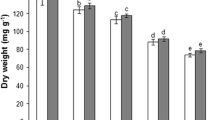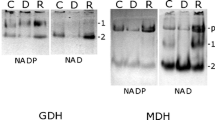Abstract
Growth and some metabolic activities ofScenedesmus armatus grown in the presence of different heavy metals (Cd, Mn and Ni) with and without exogenously added proline (Pro) were monitored. The growth ofS. armatus cells (cell concentration, pigment and dry mass) was inhibited by all these heavy metals. Addition of Pro to the culture medium minimized the toxic effect of the metals. The growth rate was somewhat higher in Pro-containing cultures and started to decline I d later than in cultures containing heavy metals alone.S. armatus cells accumulated the added Pro in response to heavy metals. The accumulation correlated with protein content. Cd was the strongest inducer of Pro accumulation, Mn being the weakest. Cells accumulated nickel more than cadmium and manganese. Heavy metal-treated cells had increased peroxidase and catalase activities.
Similar content being viewed by others
References
Adam M.S., Issa A.A.: Effect of manganese and calcium deficiency on the growth and oxygen exchange ofScenedesmus intermedius cultured for successive generations.Folia Microbiol.45, 353–358 (2000).
Aebi M.: Catalasein vitro.Meth. Enzymol.105, 121–126 (1984).
Alia, Saradhi P.: Proline accumulation under metal stress.J. Plant Physiol.132, 554–558 (1992).
Bates L.S., Walden R.P., Teare I.D.: Rapid determination of free proline for water stress studies.Plant & Soil39, 205–207 (1975).
Bradford M.: A rapid and sensitive method for the quantitation of microgram quantities of protein utilizing the principle of dye binding.Anal. Biochem.72, 248–254 (1976).
Costa G., Morel J.-L.: Water relations, gas exchange and amino acid content in Cd-treated lettuce.Plant Physiol. Biochem.32, 561–570 (1994).
De Fillipis H., Ziegler H.: Effect of sublethal concentrations of zinc, cadmium and mercury on the photosynthetic carbon reduction cycle ofEuglena.J. Plant Physiol.142, 167–172 (1993).
El-Enany A.E.: Shoot organogenesis and protein synthesis in tomato tissue cultures.Biol. Plant.39, 393–408 (1997).
El-Enany A.E., Issa A.A.: Cyanobacteria as a biosorbent of heavy metals in sewage water.Environ. Toxicol. Pharmacol.8, 95–101 (2000).
Elstner E.F., Wagner G.A., Schutz W.: Activated oxygen in green plants in relation to stress situation.Curr. Top. Plant Physiol. Biochem.7, 159–187 (1988).
Farago M.E.: Metal tolerant plants.Coord. Chem. Rev.36, 155–182 (1981).
Farago M.E., Mullen W.A.: Plants which accumulate metals—IV. A possible copper-proline complex from roots ofArmeria maritima.Inorg. Chem. Acta32, 193–194 (1979).
Grill E., Winnacker E-L., Zenk M.H.: Phytochelatins, a class of heavy metal-binding peptides from plants, are functionally analogous to metallothioneins.Proc. Nat. Acad. Sci. USA84, 439–443 (1987).
Halliwell B., Gutteridge J.M.C.:Free Radicals in Biology and Medicine, pp. 188–266. Clarendon Press, Oxford 1988.
Hammerschmidt R., Nuckles E.M., Kue J.: Association of enhanced peroxidase activity with induced systemic resistance of cucumber toColletotricum lagenarium.Physiol. Plant20, 73–82 (1982).
Issa A.A., Adam M.S., Abdel-Basset R.: Effect of Ca2+ on the detoxification of Cd2+ byScenedesmus obliquus cells at low or high temperature.Folia Microbiol.43, 645–648 (1998).
Issa A.A., Adam M.S.: Influence of selenium on toxicity of some heavy metals in the green algaScenedesmus obliquus.Folia Microbiol.44, 406–410 (1999).
Lagriffoul A., Mocquot B., Mench M., Vangronsveld J.: Cadmium toxicity effect on growth, mineral and chlorophyll contents, and activities of stress related enzymes in young maize plants (Zea mays L.).Plant & Soil200, 241–250 (1998).
Lee K.C., Cunningham B.A., Paulsen G.M., Liang G.H., Moore R.B.: Lead effects on several enzymes and nitrogenous compounds in soybean leaf.J. Environ. Qual.5, 357–359 (1976).
Marker A.F.H., Crowther C.A., Gunn R.J.M.: Methanol and acetates solvents for estimating chlorophylla and phaeopigments by spectrophotometry.Arch. Hydrobiol. Beihft. Ergebniss. Limnol.14, 52–69 (1980).
Metzner H., Rau H., Senger H.: Untersuchungen von Synchronisierbarkeit einzelner Pigmentmangel-Mutant vonChlorella.Planta65, 186–194 (1965).
Mocquot B., Vangronsveld J., Clijsters H., Mench M.: Copper toxicity in young maize (Zea mays L.) plants: effects on growth, mineral and chlorophyll contents, and enzyme activities.Plant & Soil182, 287–300 (1996).
Nikolopoulos D., Manetas Y.: Compatible solutes andin vitro stability ofSalsola soda enzymes: proline incompatibility.Phytochemistry30, 411–413 (1991).
Olmos E., Piqueras J.R., Martinez-Solano E., Hellin E.: The subcellular localization of peroxidase and the implication of oxidative stress in hyperhydrated leaves of regenerated carnation plants.Plant Sci.130, 97–105 (1997).
Pandey R., Ganapathy P.S.: The proline enigma: NaCl-treatment and NaCl-sensitive callus lines ofCicer arietinum.Plant Sci.40, 13–17 (1985).
Sharma S.D., Chopra R.N.: Effect of lead nitrate and lead acetate on growth of the mossSemibarbula orientalis (Web.) at mary-growthin vitro.J. Plant Physiol.129, 242–249 (1987).
Sigler K., Chaloupka J., Brozmanová J., Stadler N., Höfer M.: Oxidative stress in microorganisms—I. Microbialvs. higher cells—damage and defenses in relation to cell aging and death.Folia Microbiol.44, 587–624 (1999).
Steffens J.C.: The heavy metal-binding peptide of plants.Ann. Rev. Plant Physiol. Plant Mol. Biol.41, 553–575 (1994).
Stein J.R.: Growth and mating ofGonium pectorale (Volvocales) in defined media.J. Phycol.2, 23–28 (1966).
Stroiniski A., Zielezinska M.: Cadmium effect on hydrogen peroxide, glutathione and phytochelatins levels in potato tuber.Acta Physiol. Plant.19, 127–135 (1997).
Tomsett A.B., Salt D.E., Mirana J., Thurman D.A.: Metallothioneins and metal tolerance.Asp. Appl. Biol.22, 365–372 (1989).
Van Assche F., Cardinales C., Clijsters H.: Induction of enzymes capacity in plants as a result of heavy metal toxicity: dose-response relation inPhaseolus vulgaris L., treated with zinc and cadmium.Environ. Pollut.52, 103–115 (1988).
Vymazal J.: Uptake of heavy metals byCladophora glomerata.Acta Hydrochem. Hydrobiol.18, 657–660 (1990).
Xiang C.B., Oliver D.J.: Glutathione metabolic genes coordinately respond to heavy metals and jasmonic acid inArabidopsis.Plant Cell10, 1539–1550 (1998).
Author information
Authors and Affiliations
Rights and permissions
About this article
Cite this article
El-Enany, A.E., Issa, A.A. Proline alleviates heavy metal stress inScenedesmus armatus . Folia Microbiol 46, 227–230 (2001). https://doi.org/10.1007/BF02818538
Received:
Revised:
Issue Date:
DOI: https://doi.org/10.1007/BF02818538




